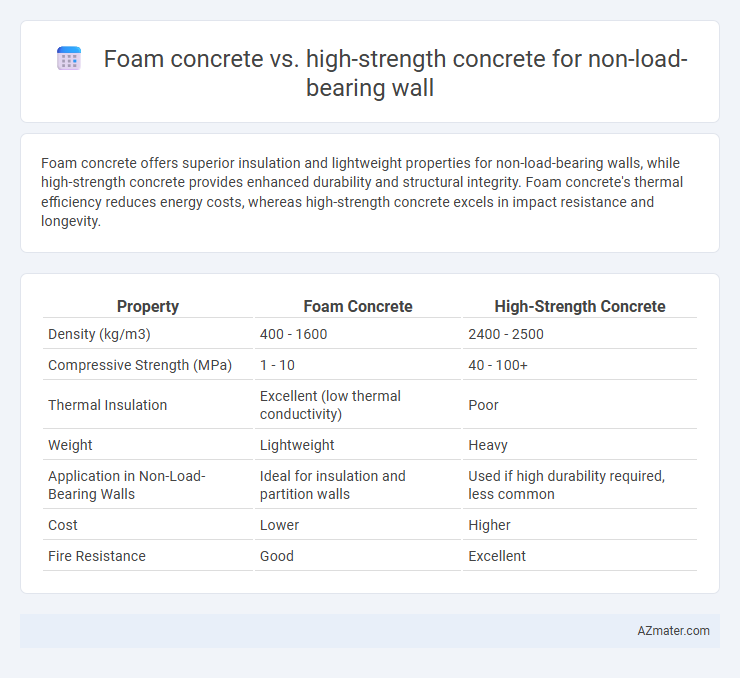Foam concrete offers superior insulation and lightweight properties for non-load-bearing walls, while high-strength concrete provides enhanced durability and structural integrity. Foam concrete's thermal efficiency reduces energy costs, whereas high-strength concrete excels in impact resistance and longevity.
Table of Comparison
| Property | Foam Concrete | High-Strength Concrete |
|---|---|---|
| Density (kg/m3) | 400 - 1600 | 2400 - 2500 |
| Compressive Strength (MPa) | 1 - 10 | 40 - 100+ |
| Thermal Insulation | Excellent (low thermal conductivity) | Poor |
| Weight | Lightweight | Heavy |
| Application in Non-Load-Bearing Walls | Ideal for insulation and partition walls | Used if high durability required, less common |
| Cost | Lower | Higher |
| Fire Resistance | Good | Excellent |
Introduction to Non-Load-Bearing Walls
Non-load-bearing walls serve primarily as partitions and do not support structural loads, making material choice crucial for weight reduction and insulation properties. Foam concrete offers excellent thermal insulation and lightweight characteristics, reducing stress on the building framework. High-strength concrete, while durable and strong, is typically heavier and less effective for insulation, making foam concrete more suitable for non-load-bearing wall applications.
What is Foam Concrete?
Foam concrete is a lightweight, cellular material composed of cement, water, and a foaming agent that creates air bubbles, resulting in reduced density and enhanced thermal insulation properties. It is ideal for non-load-bearing walls due to its low compressive strength compared to high-strength concrete, which is dense and designed for structural support. Foam concrete offers benefits such as ease of installation, sound insulation, and fire resistance, making it suitable for partitions and infill walls where load-bearing capacity is not critical.
What is High-Strength Concrete?
High-strength concrete is a type of concrete characterized by a compressive strength typically above 6,000 psi, designed for structural applications requiring enhanced durability and load-bearing capacity. Unlike foam concrete, which is lightweight and primarily used for insulation and non-load-bearing partitions, high-strength concrete incorporates low water-to-cement ratios and high-quality materials to achieve superior mechanical performance. This makes high-strength concrete less suitable for non-load-bearing walls where weight reduction and thermal insulation are prioritized.
Composition and Material Differences
Foam concrete for non-load-bearing walls consists primarily of cement, water, and air bubbles introduced by foam agents, resulting in a lightweight, low-density material with high thermal insulation but lower compressive strength typically around 1-5 MPa. High-strength concrete is made from a dense mix of cement, fine aggregates, coarse aggregates, and chemical admixtures like silica fume or fly ash, achieving compressive strengths exceeding 40 MPa and providing superior durability and load resistance. The key material difference lies in foam concrete's porous structure due to entrained air, which reduces weight and strength, whereas high-strength concrete's dense matrix enhances structural capacity but increases weight.
Weight and Density Comparison
Foam concrete typically has a density ranging from 400 to 1600 kg/m3, making it significantly lighter than high-strength concrete, which generally ranges between 2400 and 2500 kg/m3. This reduced weight in foam concrete is advantageous for non-load-bearing walls as it decreases the overall structural load and improves thermal insulation. High-strength concrete, despite its superior compressive strength, is less suitable for such walls due to its higher density and weight, which can lead to increased structural costs and complexity.
Thermal and Acoustic Insulation Properties
Foam concrete exhibits superior thermal insulation due to its lightweight cellular structure, reducing heat transfer and enhancing energy efficiency in non-load-bearing walls. High-strength concrete offers limited insulation properties but provides greater compressive strength and durability. Foam concrete also excels in acoustic insulation by absorbing sound waves, making it ideal for noise reduction applications in residential and commercial buildings.
Workability and Ease of Construction
Foam concrete offers superior workability and ease of construction for non-load-bearing walls due to its lightweight, flowable nature, which simplifies handling and application with minimal labor and equipment. High-strength concrete, while providing higher compressive strength, is dense and less workable, requiring more skilled labor and vibration during placement that complicate installation. The porous structure of foam concrete enhances insulation and reduces construction time, making it ideal for non-load-bearing partitions where structural load resistance is not critical.
Cost and Economic Considerations
Foam concrete offers significant cost advantages for non-load-bearing walls due to its lightweight composition, reducing transportation and labor expenses compared to high-strength concrete. The lower density of foam concrete also leads to decreased material costs and improved thermal insulation, providing energy savings over time. Although high-strength concrete delivers superior durability, its higher initial price and installation complexity often make foam concrete the more economical choice for non-structural applications.
Durability and Maintenance Factors
Foam concrete offers superior thermal insulation and lightweight properties for non-load-bearing walls but may require regular maintenance due to its lower compressive strength and potential for moisture absorption, impacting long-term durability. High-strength concrete provides enhanced durability and resistance to environmental wear, reducing maintenance frequency and improving lifespan in non-structural wall applications. Selecting between foam concrete and high-strength concrete depends on balancing insulation benefits with durability needs and maintenance costs in specific construction environments.
Suitability: Foam vs High-Strength Concrete for Non-Load-Bearing Walls
Foam concrete offers excellent insulation and lightweight properties ideal for non-load-bearing walls, promoting ease of installation and thermal efficiency. High-strength concrete, while structurally robust, is often excessive for non-load-bearing applications, leading to higher costs and unnecessary weight. Choosing foam concrete enhances energy efficiency and reduces construction time, making it more suitable for partition walls and infill panels where load-bearing capacity is not critical.

Infographic: Foam concrete vs High-strength concrete for Non-load-bearing wall
 azmater.com
azmater.com